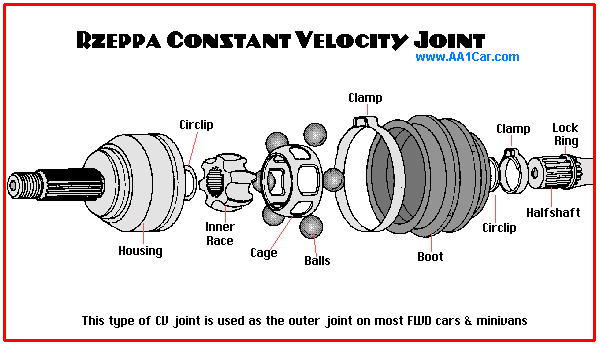
Home, Auto Repair Library, Auto Parts, Accessories, Tools, Manuals & Books, Car BLOG, Links, Index



Rebuilding a worn constant velocity joint is NOT something you can do on your own vehicle. But if you are buying a replacement halfshaft, chances are one or both of the joints may have been rebuild.
There has been a great deal of controversy among component parts rebuilders over the pros and cons of grinding constant velocity joints, but it is mostly a rhetorical debate these days because everybody who is in the front-wheel drive axle shaft rebuilding business knows it is difficult to be price competitive with FWD halfshafts unless the CV joints are reground (rather than new). Whether or not grinding works, therefore, is not the real issue anymore. The issue is the best way to grind CV joints
To minimize the cost of rebuilding a FWD shaft, the CV joints are typically remachined or ground rather than replaced if they are worn.
According to several rebuilders, roughly half the CV joints they rebuild are salvaged and reconditioned by grinding. Another 20 to 30 percent can be rebuilt using sightly oversize (.001 to .003 inch) balls and cages. An equal number often do not need much of anything except cleaning and reassembly with fresh grease. And only about ten percent are unrebuildable because they are broken, cracked or damaged beyond repair.
HOW MUCH METAL CAN BE SAFELY REMOVED FROM A CV JOINT?
No one disputes the fact that grinding can salvage many CV joint components that would otherwise have to be discarded and replaced. But opinions differ on the effects of grinding on joint durability. The emerging consensus of opinion is that grinding does no harm as long as it does not go too deep. The depth of the case hardening on CV joints varies depending on the application and process used (induction hardening or carburizing), but typically ranges from .048 inch to .100 inch or more. Limiting the amount of material removed to .010 inch to accommodate a .020 inch oversized ball, therefore, should have virtually no significant effect on joint durability. Consequently, a .010 inch cut has become an "unofficial" standard for many who grind joints.
PRODUCTION GRINDING
The key to reconditioning a CV joint by grinding, say those who do it, is to duplicate the original arc in the housing and race, a process which requires precision grinding on a CNC machine. It simply cannot be done by hand.
If someone buffs out a dimple in a track by hand with a die grinder, it may create a low spot or pocket in the track. It does not fix the problem nor does it restore proper clearances inside the CV joint. The entire length of the track must be precision ground on a CNC machine to duplicate the arc of teh original track.
CV JOINT GRINDING STANDARDS NEEDED?
Because some companies who rebuild front-wheel drive halfshafts do nothing more than a "wash and paint job" job on the shafts they rebuild. Others may try to salvage worn CV joints by hand grinding. The end result is a poor quality product that won't last.
There has also been a lot of discussion both within and outside the rebuilding industry for adopting standards on rebuilding and grinding CV joints. The Society of Automotive Engineers (SAE) developed a recommended practice (J1620) for rebuilding front-wheel drive axles which did not allow grinding. But the proposal was shelved when a study by APRA showed worn CV joints could be safely reground.
The APRA study is also looked at the geometry of the joint. There are a number of different ways a joint can be ground. But it must be done correctly to restore internal tolerances.
Another question is how many times a CV joint can be safely reground? Can they be rebuilt a second or third time? With a product like a starter, six to nine rebuilds may be possible before the core is unusable. But with CV joints, the consensus is that one rebuild is probably the limit. Others say it may be possible to grind another .005 inch from a joint that has been reground one before, provided the original balls were replaced with .030 inch oversized balls.
According to some CV joint rebuilders, regrinding a worn CV joint is actually more difficult than manufacturing a new joint. When new joints are manufactured, the same forgings are run on the same tooling in long production runs. But when used joints are rebuilt, there is a lot of variance from one joint to the next even for the same model year application. The tracks the balls ride in may not be exactly 60 degrees apart. The tracks in some CV joints may be off as much as .004 to .005 inch from flute to flute.
What is more, the tracks have to be ground in such a way as to restore not only the original geometry of each ball track end to end but also the proper cross section of each groove. The entire surface of the ball does not actually make full contact with the groove in the inner race but makes contact at two points because the groove is somewhat wider than it is deep. This is called a "Gothic arch" because of the shape. The Gothic arch reduces friction, so if the inner race is reground spherical rather arched premature joint failure will occur.
Housings, on the other hand, can be ground so the ball makes full contact with the groove. Window openings in cages must be perfectly parallel to one another and sized to the ball. If a cage window is not parallel or ground perfectly flat, it will click or wear prematurely.
The key to all of this is removing all the wear from the joint without changing its basic geometry.
 More Front-Wheel Drive Articles:
More Front-Wheel Drive Articles: Click Here to See More Carley Automotive Technical Articles
Click Here to See More Carley Automotive Technical Articles